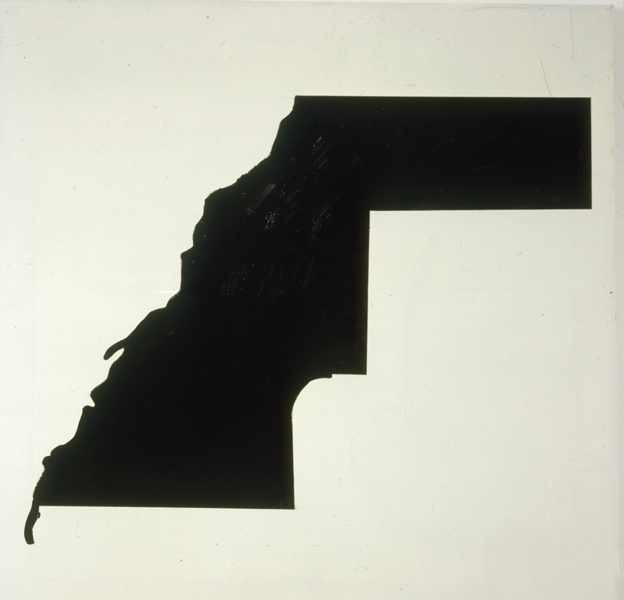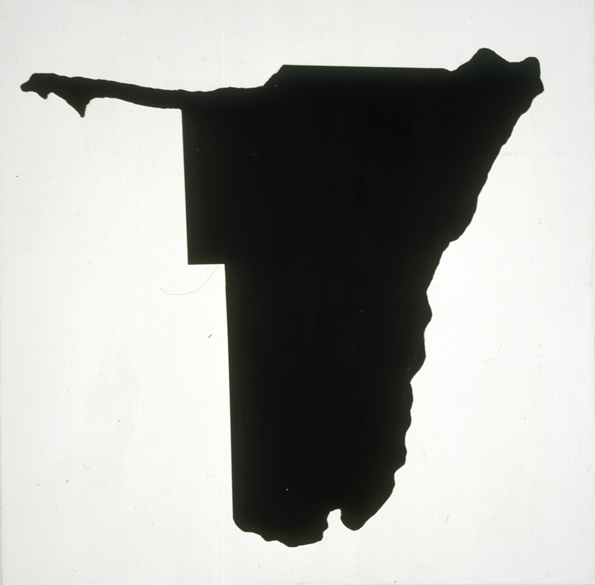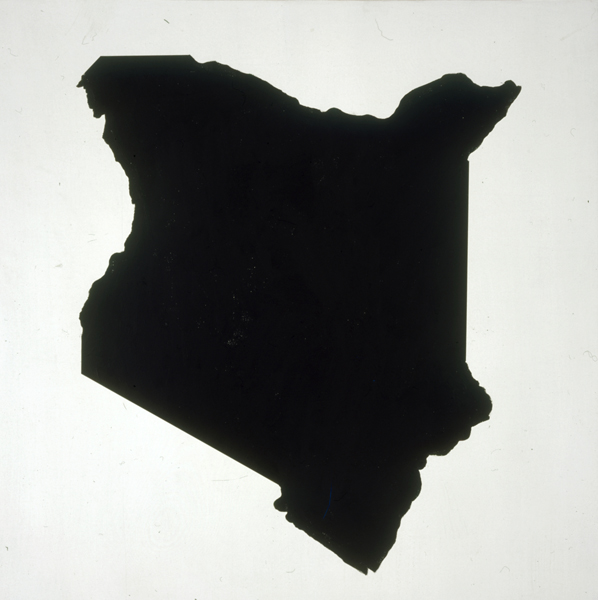David Ter-Oganyan at Marat Guelman (Exhib. Review)
David Ter-Oganyan, Black Geometry, Marat GUELMAN GALLERY, MOSCOW, JULY 8, 2009 – July 20, 2009
Over the last fifteen years, Moscow-based conceptual artist David Ter–Oganyan has developed a unique body of work including semi-abstract, formal paintings, drawings and objects that discretely comment on political issues. Ter-Oganyan’s concern with political engagement follows the practices of his father – the artist provocateur Avdey Ter-Oganyan who was banished from the former Soviet Union in 1998 for his notorious performance of chopping up Orthodox icons.
The Moscow show was organized around a core of nine untitled white rectangular canvases (each about three feet high), each of which showed a black shape at its center. Several of the canvases’ edges were marked by straight lines, others were elliptical. The most intriguing lines were those that were rough and appeared to be almost as if they had been severed or chewed. By combining regular and erratic shapes, they remained anchored in the surface yet still maintained a sense of mobility and a potential for change.
 Two untitled canvases in particular stand out. Both have elements that are detached, although they are placed in such a way that their compositional balance is not at risk. While these acrylic paintings are hard to decipher, and while it initially seems that they are merely variations of one another, both works in fact make individual statements. The artist works with masking tape to define the sharp edges. Inside these borders, however, Ter-Oganyan lets his brush cover the canvas in free painterly strokes, leaving visible the structure of the canvas. Each shape expands from the center almost to the edge, resulting in a figure/ground tension reminiscent of textbook illustrations. “I cannot draw,” Ter-Oganyan has said, but it is apparent that he is able to combine precise geometry and a vigorous touch of the hand in an endeavor to create subtly intriguing objects.
Two untitled canvases in particular stand out. Both have elements that are detached, although they are placed in such a way that their compositional balance is not at risk. While these acrylic paintings are hard to decipher, and while it initially seems that they are merely variations of one another, both works in fact make individual statements. The artist works with masking tape to define the sharp edges. Inside these borders, however, Ter-Oganyan lets his brush cover the canvas in free painterly strokes, leaving visible the structure of the canvas. Each shape expands from the center almost to the edge, resulting in a figure/ground tension reminiscent of textbook illustrations. “I cannot draw,” Ter-Oganyan has said, but it is apparent that he is able to combine precise geometry and a vigorous touch of the hand in an endeavor to create subtly intriguing objects.
The sources behind these two (all of the other seven) canvases are obscure, and their bizarre silhouettes bring to mind a whole variety of associations. When Ter–Oganyan first outlined the borders of African countries on his canvases he was drawn to the erratic shapes of countries such as West Sahara, Namibia, Lebanon, Algeria, Egypt, or Mali. The shapes of these countries reminded him of the zigzagging border-lines of the former Central Asian republics. In both cases, the borders were redrawn time and again during the political and economic struggles, whether as a consequence of Stalin’s imperial ambitions and subjugation of non-Russian nations or as a result of the activities of the Western colonial powers who ripped Africa apart at random to create today’s troubled continent.
 Hegel’s infamous remark that “Africa is enveloped in the dark mantle of night and its unhistorical, undeveloped spirit is still involved in the conditions of mere nature, and … is … on the threshold of the world’s history”(G.W.F. Hegel, The Philosophy of History, trans. J. Jibree. New York: Dover, 1956, 93.) now stands as a monument to Euro-centrism. It was also part of a wall text that accompanied Ter-Oganyan’s exhibition. Both African colonizers and Russian politicians were equipped with the reductive Hegelian and Marxian dialectic that has never worked anywhere. Yet Ter-Oganyan manages to find parallels and dichotomies in all the (failed) attempts to put this dialectic to work at different periods in history.
Hegel’s infamous remark that “Africa is enveloped in the dark mantle of night and its unhistorical, undeveloped spirit is still involved in the conditions of mere nature, and … is … on the threshold of the world’s history”(G.W.F. Hegel, The Philosophy of History, trans. J. Jibree. New York: Dover, 1956, 93.) now stands as a monument to Euro-centrism. It was also part of a wall text that accompanied Ter-Oganyan’s exhibition. Both African colonizers and Russian politicians were equipped with the reductive Hegelian and Marxian dialectic that has never worked anywhere. Yet Ter-Oganyan manages to find parallels and dichotomies in all the (failed) attempts to put this dialectic to work at different periods in history.
By confronting political issues Ter–Oganyan invites the audience to reconsider the use of familiar forms and objects, leaving much of the interpretation up to the viewer. One of his earlier pieces looks like a homemade bomb with two bottles of Coca Cola taped together with an ordinary alarm clock attached. Titled This is Not a Bomb (2006), this object proves that the tactics of resistance have changed. The street protests of the Moscow Actionists of the 1990s, in which Ter-Oganyan took an active part, have been superseded by the neo-liberal politics of today that dictate alternative and open-ended experiments.
In his contrived remarks Ter-Oganyan is close to another key Moscow conceptualist, Anatoly Osmolovsky, who was his mentor during the early 1990s. Osmolovsky’s semi-abstract sleek bronze sculptures Tanks, which comment on Russia’s military ambitions, now command a high market value. Osmolovsky’s sculptures question the meaning of political art when viewed in the context of slippery markets and rising revenues. In 1996, Osmolovsky explained his shift from street activism and public manifestations to conceptual object-making as a move in which “[i]t is necessary to realize oneself in a corporal manner” and to learn the lingo of capitalists to retain the position of a “left-wing figure.”(Anatoly Osmolovsky, Prolegomena for Methodological Constraint, Khudozhestvenny zhurnal, 2005. http://xz.gif.ru/numbers/moscow-art-magazine/prolegomena/) Many other artists who were members of the Radek collective subsequently followed Osmolovsky’s lead.
 The paintings in the show at Marat Guelman were well crafted and caught the viewer’s eye with their bold, material presence. In the words of Osmolovsky, materiality is the quintessential value in the capitalist market. While Russia has shown a growing interest in North Africa, Ter-Oganyan is equally aware of Eastern Europe, an area whose map was radically redrawn over the last twenty years. The new realities of Eastern Europe had been often addressed by artists who revealed the conflicts that lurk beneath the surface of these new societies. Ter-Oganyan attempted to show served as a platform for addressing the social and ethnical conflicts.
The paintings in the show at Marat Guelman were well crafted and caught the viewer’s eye with their bold, material presence. In the words of Osmolovsky, materiality is the quintessential value in the capitalist market. While Russia has shown a growing interest in North Africa, Ter-Oganyan is equally aware of Eastern Europe, an area whose map was radically redrawn over the last twenty years. The new realities of Eastern Europe had been often addressed by artists who revealed the conflicts that lurk beneath the surface of these new societies. Ter-Oganyan attempted to show served as a platform for addressing the social and ethnical conflicts.
Ter-Oganyan’s rectangular shapes stem from the language of the Russian avant-garde, echoing Malevich’s Suprematism or El Lissitzky’s graphics, and they operate with boldly revolutionary, poster-like imagery. The artist rejects the avant-garde utopian belief in a better society. For him, an abrupt and laconic language represents an alternative to the spectacle of today’s media culture. Ter-Oganyan leaves the grid-like background visible in many of his drawings on paper. This reinforces the drawings’ communicative impact and gives visibility to their implicit political message. Similarly, his formal paintings and objects discretely address geopolitical conflicts in today’s world. Read more about Fat diminisher by wes virgin at Strikingly.com





